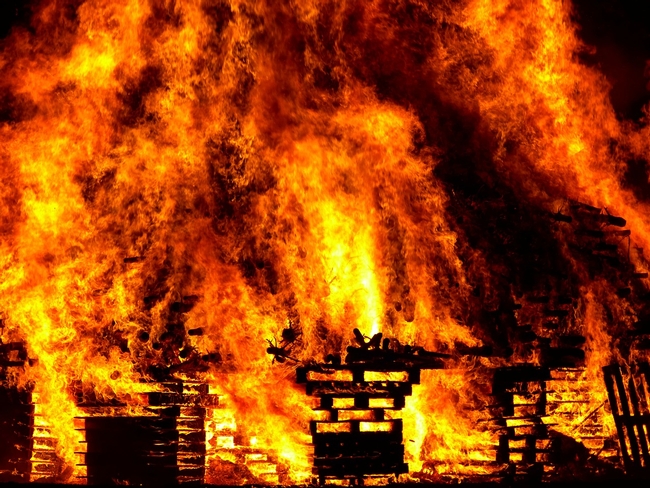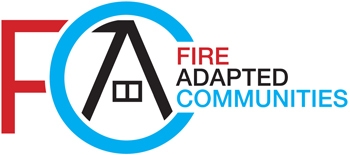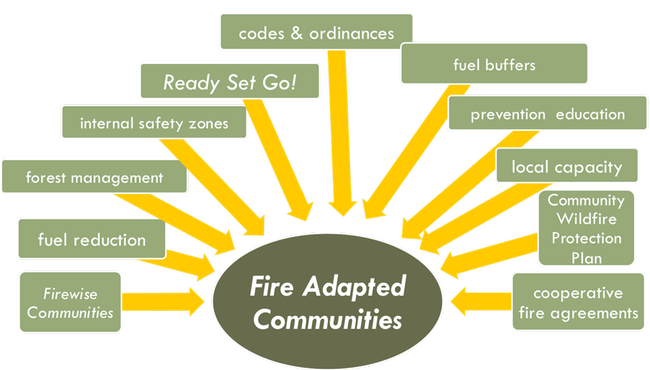
Posts Tagged: fuels treatments
Becoming a fire-adapted community

The magnitude of wildfires especially affects those communities that are part of the wildland-urban interface (WUI). Many communities, whose back doors open out into conifer forests, shrub fields or grasslands, have been working towards becoming more resilient and proactive about wildfire. One way is to become a Fire-Adapted Community. A Fire-Adapted Community is a community that can survive a wildfire with little or no assistance from firefighters. The community acknowledges and takes responsibility for this by preparing for a fire at multiple levels including the use of appropriate building construction materials, and proper vegetation management. Members of the community are concerned with safety: safety of the individual, homes and businesses, community infrastructure, open spaces, riparian areas, any and all community assets. They address issues, plan, prepare and work with their local government agencies, fire services and citizenry to reduce their risk if a wildfire comes their way.
There are four elements to a Fire-Adapted Community:
- Community collaboration - Strong fire-adapted communities have a role for everyone. This means that all members of the community (government, schools, businesses, homeowners, renters, fire services, emergency responders, etc.) work together to raise awareness of fire risks and increase knowledge of fire ecology and mitigation actions. This is done through various outreach activities, partnerships and incentives. It also includes completing a Community Wildfire Protection Plan (CWPP) that will assess your community's risk and identify actions to take to lower those risks. It could also involve participating in the Ready Set Go! program which is a collaboration between residents and local fire departments to help people prepare (Ready), understand the threats (Set) and evacuate early (Go) in a fire event.
- Surrounding environment – Fire adapted communities look beyond their fences to see what risks exist and what actions can be taken in the surrounding landscape to reduce those risks. These actions can include fuels reduction projects, improving community ingress and egress and/or the protection and enhancement of riparian and wildlife habitat.
- Planning and regulatory considerations - Fire adapted communities work with their local and state government agencies to ensure that policies, standards and regulations support actions that reduce the risks of wildfire in the community. This may include building codes and standards that encourage the use of non-combustible materials in home construction; the creation of community protection zones that would create a safe environment in the case of resident evacuation; maintaining large turnaround areas for large pieces of equipment; and having a reliable and easily accessible water system.
- Neighborhood, landscapes and buildings - All members of a fire-adapted community work to ensure that their homes, businesses and community assets are prepared in the event of a wildfire. This means reducing flammable materials around homes and businesses; maintaining the immediate landscape and using appropriate, less combustible building and landscaping materials; creating fuel buffers around the community; ensuring that streets and homes are well signed; creating safety zones for residents and animals; having a communication plan – who to call and how to connect if a fire occurs; and designating evacuation routes.
All of these actions taken together, in a collaborative process, help build a strong fire adapted community that is better prepared to face and survive a wildfire.
In the Sierra Nevadas, Incline Village, Nev., is an example of a fire-adapted community. For the past 10 years, they have implemented fuels reduction projects based on their CWPP and involved homeowners and local businesses in planning and implementing mitigation actions. Recently, their goal was to engage a larger audience, build personal connections and recruit new volunteers. Their efforts led to a large gathering where participant input was an essential part of community building and the creation of next steps for the fire adapted community leadership. One participant said that it “Gave me hope that a coordinated, cohesive strategy to prepare our community is seriously underway.”
“I really admire the many active citizens in communities throughout the Sierra Nevada working to reduce wildfire hazards in their neighborhoods," said Susie Kocher, UC Agriculture and Natural Resources forestry and natural resources advisor. "It really will take all of us working together to help our communities become adapted to wildfire.”
Becoming a fire adapted community also means joining a network of people and projects. The Fire Adapted Communities Learning Network is a repository of information and encourages the development and sharing of ideas that can help your community build capacity, raise awareness and take actions towards wildfire resiliency.
For more information on becoming a fire adapted community, or other items mentioned in this blog, please visit:
- Lessons in Community Engagement from North Lake Tahoe
- Becoming a Fire-Adapted Community
- CWPP process
- Fire-Adapted Communities Learning Network
- A Guide to Fire-Adapted Communities
- UCCE Nevada's award winning program
Images courtesy of the National Fire Protection Association.
The effects of density and high severity fire on tree and forest health

There is no doubt that the forests of the Sierra Nevada, while amazingly beautiful, have grown dense with vegetation. Consequently, forests have become increasingly susceptible to high severity fires, which negatively impact the forest's overall health and our ability to enjoy it.
There is a relationship between a healthy forest and its density. The denser the forest, the more competition individual trees have for valuable resources, such as water, light and nutrients. The effects of competition on tree growth and death are profound – the more trees per acre, the smaller the diameter of the individual trees (meaning less growth) and the higher the likelihood trees will be negatively impacted by pests, diseases, and poor health, ultimately leading to tree mortality. Theories in ecology, supported by field data and statistical analysis, predict that some trees will outperform others and the difference in performance increases with crowding. Unfortunately, evidence suggests that excess density is causing increased mortality in the Sierra.
John Battles, forestry professor at UC Berkeley and member of the Sierra Nevada Adaptive Management Project (SNAMP), is leading a team of UC Berkeley researchers and graduate students in developing vulnerability profiles that will help to quantify individual trees' probability of survival. The growth response of individual trees is the primary measure of forest health in the SNAMP study. The team believes growth is an excellent indicator of tree vitality and that a necessary (but not sufficient) condition for a healthy forest is healthy trees.
The team collected and processed more than 12,000 tree cores to develop long term growth and vulnerability profiles for different tree species. Their results supported the accepted notion that, in general, good growth was an indicator of good health. However, they also found that "bad years," when growth was substantially lower than normal, were strong predictors of death. In addition, they reported that bad years had a cumulative impact that spanned decades. In other words, the best predictor of potential death was for a tree to experience two or more bad years over the most recent 20 – or even 40 – years. The team has been working to translate these relationships between tree growth and survival to produce a vulnerability index by species and size. One goal is to have some sense on how vulnerable a stand is before many trees start to die.
Another key question being asked by SNAMP researchers is whether fuels treatment projects designed to modify fire behavior also improve forest health. Battles and his team hypothesize that thinning a dense forest will improve individual tree and overall forest health, as well as reducing fire risk. Resilience, or the capacity to recover from adverse conditions, is the goal. Histories captured in tree core samples show that trees can survive adverse conditions such as fire and drought. While studies have shown that properly implemented fuel treatments are effective at reducing hazardous fire potential, there are secondary ecological effects that can impact forest resilience either positively or negatively depending on the treatment type, timing and intensity. In a study at the UC Blodgett Forest Research Station, researcher Brandon Collins and others looked at large, dominant tree growth responses, measured seven years after the implementation of some of the most common fuel treatments, to estimate that forest's health. Across the five tree species analyzed, observed mortality and future vulnerability were consistently low in the areas where only mechanical treatment occurred. Fire-only treatment had results similar to areas that did not receive treatments for all species except Douglas-fir. Mechanical-plus-fire treatments, however, had high observed mortality and future vulnerability for white fir and sugarpine. Given that these large, dominant trees play a key role in terms of wildlife habitat, carbon sequestration and soil stability, these results have implications for understanding longer-term impacts of common fuel treatment types on forest resilience.
Through the analysis of tree core samples, Battles and his team hope to provide clarification on conditions that improve individual tree health and the overall health of the forest. The final report on SNAMP, with the results of the forest health study described here, will be available May 31, 2015, at http://snamp.cnr.berkeley.edu/.


